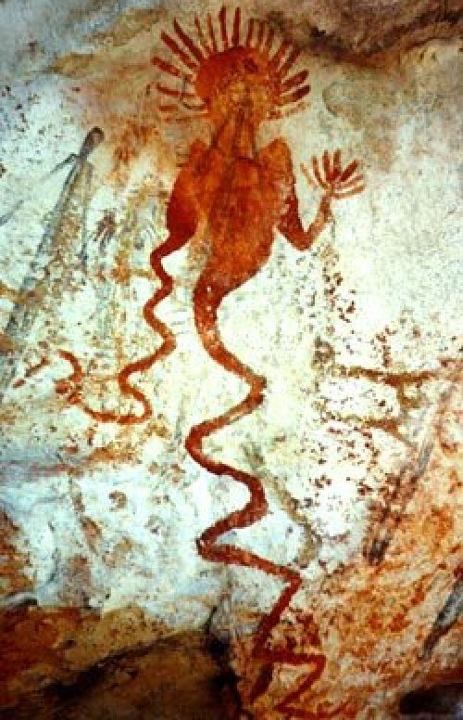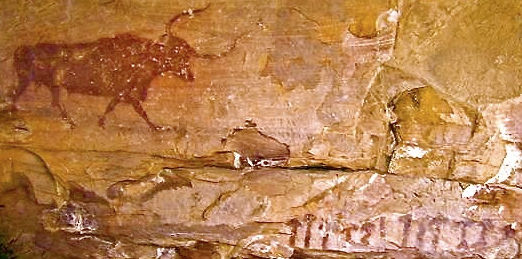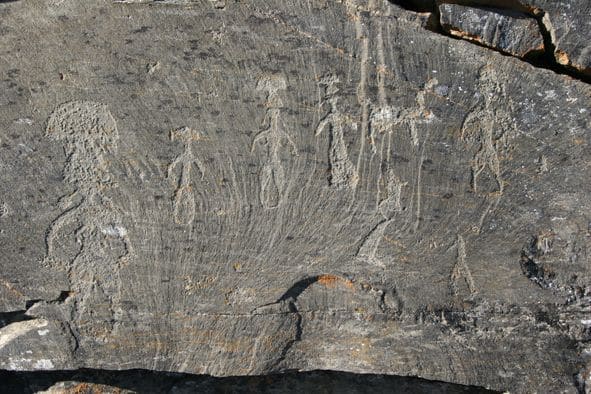Ancient Psychedelia: Alien Gods & Mushroom Goddesses
Online Book - Chapter 1, Page 8
Back to Online Book Mainpage / Next Page (Chapter 1, Page 9)
 (7e) USA The stag-man, or early shaman figures prominently in ancient cave art and is most popularly portrayed in the Altamira caves of Cantabria, Spain and in the Cavern des Trois Freres at Ariege in the French Pyrenees, which date from approximately 20,000 BC (25). Also, at Altamira, Spain, there exists cave art depicting bulls and bison that date to 20,000 years ago. One particular image which I believe is from Altamira depicts a mushroom headed figure with one mushroom hand and a serpent’s tail for another hand, along with a serpent’s tail as legs (5a). The date I have for this image is 35,000 years ago, but this is not verified by me, nor is the location just yet. Regardless of its exact date and location, this image is likely the first known drawing to portray the presence of the serpent and mushroom combined in one image. This will become a very frequent theme in the future of ancient art, as we will see.  (5a) Altamira Caves, Spain c. 34,000 BC The Selva Pascuala mural exists in a cave near the town of Villar del Humo, in Spain, and is thought to date c. 4000 BC. The cave mural has an image of a cow and a row of mushrooms which look very similar to a psilocybin variety (7c).  (7c) Selva Pascuala, Spain c. 4000 BC |
Russian Archaeologist N.N. Dikov, from Siberia, in 1967-68, first discovered mushroom petroglyphs on the eastern bank of the Pegtymel River. Mushroom headed people are portrayed along with reindeer, wolves, and fish (7g). It is estimated so far, that these were painted from the end of the Stone Age to the beginning of the Bronze Age (8000 BC – 1000 BC). (26) This is quite a span of time to speculate on, but I suppose it gives room for error. I would speculate that they are possibly ten thousand years old or more. They represent a very primitive lifestyle and association with nature, which, when compared to similar petroglyph from other areas around the world, bring us to a date closer to 10,000 BC. (7g) Near the Eastern bank of the Pegtymel River in Siberia c. 8000-1000 BC In Khakassia, Siberia, there are petroglyphs which date to 3000 BC, which are said to have been made by Turkish people who were inhabiting Siberia at the time (6b). These images depict “menorah-mushroom” headed people for the first time and suggest to us that the mushroom influenced the design which later became the menorah in Hebrew tradition. There is also art from southern Siberia, from the Оkunev culture dating back to the 2nd century BC (6f), which depicts similar artwork to the Wandjina art in Australia portraying a mushroom deity with a halo or what some might call “sun rays” emanating around the head area. This is very common on early cave art. There is also similar art found in Toro Muerto, Peru which date back approximately 12-14,000 years (7i). (25) The White Goddess: A Historical Grammar of Poetic Myth, Robert Graves, McGraw, Hill, 1966 (1948), p. 217 (26) Persephone’s Quest – Wasson, Ott, Ruck, Kramrisch, Yale University Press, 1986. P.68 |
Go Back to Page 7